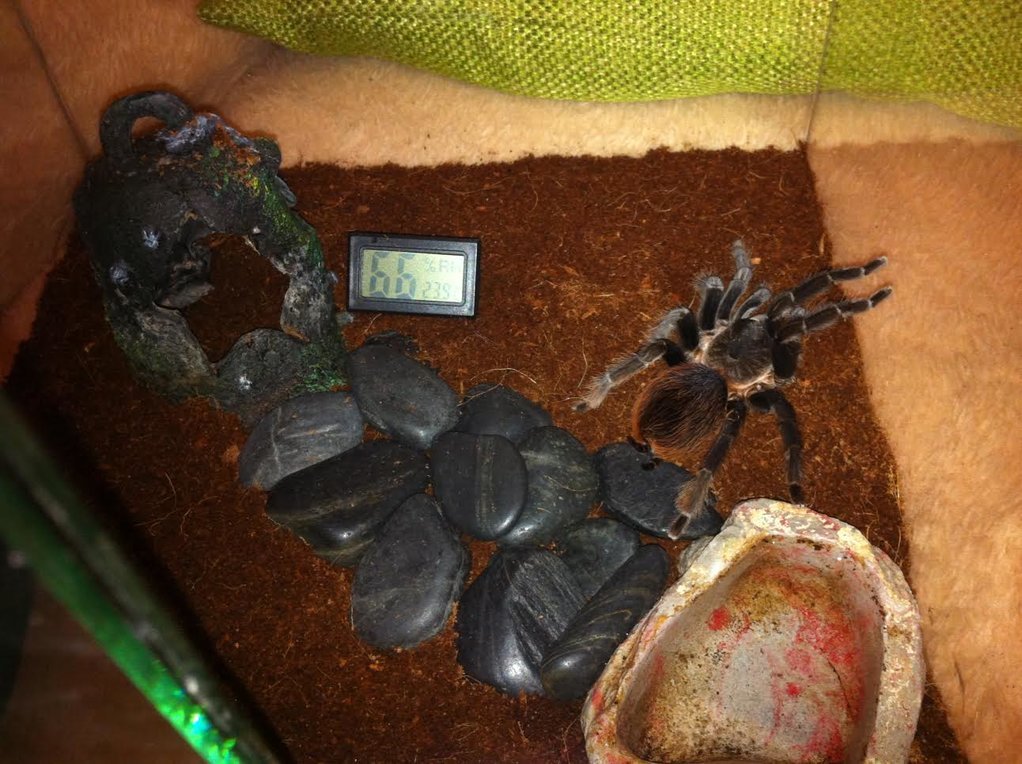Brachypelma vagans, commonly known as the “Mexican Red Rump Tarantula,” is a species native to Mexico and Central America. Known for its striking red abdomen and black body, this tarantula has become a favorite among exotic pet enthusiasts due to its appearance and behavior. This guide covers everything you need to know about Brachypelma vagans.
Natural Habitat
Brachypelma vagans is found in the hot and humid regions of Mexico and Central America’s forested areas. This tarantula species typically inhabits underground tunnels or the areas around tree roots. They prefer to hide in their burrows during the day and hunt at night. In their natural habitat, temperatures generally range from 24-28°C (75-82°F) with humidity levels between 60-80%.

Physical Characteristics
Brachypelma vagans has a shiny black body with a red-orange abdomen. Adult females can have a leg span of about 13-15 cm (5-6 inches), while males are usually slightly smaller. Their distinctive thick legs and dense hair make them easily recognizable.

Behavior and Lifestyle
This species is generally calm and slow-moving. They use their back legs to flick urticating hairs as a defense mechanism. Brachypelma vagans prefers to stay hidden in its burrows during the day and becomes active at night. They are not typically aggressive towards humans but can become defensive when threatened.
Feeding Habits
In the wild, Brachypelma vagans feeds on insects, small invertebrates, and occasionally small rodents. They capture their prey using their venomous fangs to immobilize and digest them. In captivity, they can be fed crickets, grasshoppers, and worms.
Danger to Humans
Brachypelma vagans is generally not aggressive towards humans. However, they can flick urticating hairs or bite when disturbed. Their bites are typically not dangerous, but allergic reactions can occur. The best approach when threatened is to remain calm and avoid disturbing the tarantula.

Conditions for Keeping at Home
Brachypelma vagans is quite popular as an exotic pet. To keep them at home, a suitable terrarium should be prepared. The terrarium base should be lined with moist peat or coconut fiber, and a hiding place should be provided. The temperature should be maintained between 22-26°C (72-79°F) with humidity levels around 60-70%. A water dish in the terrarium helps maintain humidity.
Terrarium Setup
An ideal terrarium for Brachypelma vagans should be at least 30x30x30 cm. The base of the terrarium should be lined with a substrate that retains moisture and allows for burrowing, such as coconut fiber or peat moss. Additionally, a hiding place or cork bark should be provided.
Temperature and Humidity Control
Maintaining the correct temperature and humidity levels is crucial for your tarantula’s health. The daytime temperature should be between 22-26°C (72-79°F) and slightly cooler at night. The humidity should be around 60-70%. A water dish in the terrarium helps maintain humidity.
Feeding and Water
Brachypelma vagans should be fed weekly. Suitable live foods include crickets, grasshoppers, and worms. The water in the terrarium should always be clean and fresh, and the water dish should be easily accessible.
Maintenance and Cleaning
The terrarium should be cleaned regularly. Food leftovers and droppings should be removed to prevent bacterial growth. The substrate should be completely replaced once a month.
Safety Measures
To avoid stressing your tarantula, try not to open the terrarium too often. Avoid disturbing it, especially during molting periods. Regularly check your tarantula to ensure it is healthy.

Reproduction and Life Cycle
Female Brachypelma vagans lay between 100-300 eggs after mating, which hatch in about 8-10 weeks. With proper care, these tarantulas can live for 10-15 years. Maintaining the right temperature and humidity is crucial for the well-being of the offspring.
Care and Feeding of Spiderlings
Spiderlings (baby tarantulas) are very delicate and require careful attention. Initially, they do not need frequent feeding but should always have access to water. As they grow, they should be moved to a larger terrarium and fed appropriately sized insects such as fruit flies or small crickets.
Common Issues and Solutions
Common issues in captive tarantulas include humidity imbalances and poor nutrition. The substrate and decorations should be sterilized to prevent parasites. Leftover food should be removed promptly to avoid mold and bacteria growth.
Conclusion
Brachypelma vagans is an excellent choice for exotic pet enthusiasts. With its striking appearance and manageable care requirements, it can thrive for many years with proper attention. This guide aims to answer all your questions about caring for Brachypelma vagans.




